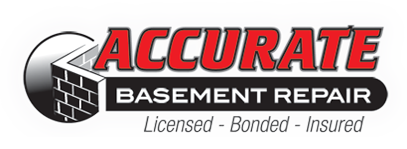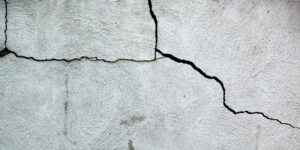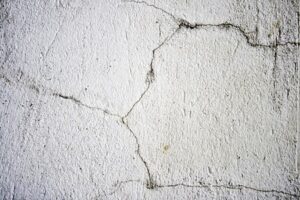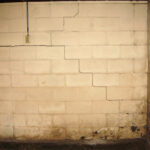The foundation is the bedrock of any structure, providing essential support and stability. Unfortunately, foundation wall cracks are a common issue that can compromise the integrity of a building. In this comprehensive guide, we will explore the various causes of foundation wall cracks, the potential consequences for your home, and the most popular methods for repairing them. Understanding these aspects is crucial for homeowners seeking to protect their investment and maintain a structurally sound property.
I. Understanding the Causes of Foundation Wall Cracks:
A. Settlement:
One of the primary reasons for foundation wall cracks is settlement. Settlement occurs when the soil beneath the foundation shifts, leading to the foundation settling unevenly. This differential settlement can result in cracks as the structure adjusts to the changing ground conditions.
B. Hydrostatic Pressure:
Hydrostatic pressure, caused by water in the soil surrounding the foundation, is another common cause of cracks. Excess water in the soil exerts pressure against the foundation walls, leading to cracks as the concrete struggles to withstand this force.
C. Poor Construction Practices:
Inadequate construction practices, such as insufficient reinforcement or the use of low-quality materials, can contribute to the development of foundation wall cracks. Improperly compacted soil or substandard concrete mixtures may also play a role in the formation of cracks.
D. Temperature Fluctuations:
Extreme temperature fluctuations, especially in regions with harsh climates, can cause concrete to expand and contract. Over time, this thermal movement can result in the development of cracks in the foundation walls.
II. Consequences of Foundation Wall Cracks:
A. Structural Compromises:
Foundation wall cracks can compromise the structural integrity of a building. As cracks widen or deepen, they may weaken the foundation, potentially leading to uneven settling and structural imbalances.
B. Water Intrusion:
Cracks in foundation walls provide a pathway for water to enter the basement or crawl space. This water intrusion can lead to issues such as dampness, mold growth, and even flooding if not addressed promptly.
C. Decreased Property Value:
Visible foundation wall cracks can reduce the curb appeal and overall value of a property. Potential buyers may view foundation issues as a significant concern, impacting the marketability of the home.
D. Pest Infestations:
Foundation cracks create entry points for pests such as termites, ants, and rodents. These unwanted visitors can further damage the structure and pose health risks to occupants.
III. Types of Foundation Wall Cracks:
A. Vertical Cracks:
Vertical cracks typically run straight up and down and are often a result of settling or shrinkage in the concrete. While small vertical cracks may not pose an immediate threat, larger or widening cracks require attention.
B. Horizontal Cracks:
Horizontal cracks are more concerning as they can indicate pressure from soil or water against the foundation walls. These cracks may lead to structural issues and water intrusion.
C. Diagonal Cracks:
Diagonal cracks often appear at a 45-degree angle and may indicate a combination of settlement and lateral pressure. The severity of diagonal cracks depends on various factors, including the size and direction of the crack.
D. Stair-Step Cracks:
Stair-step cracks typically occur in masonry foundations and resemble a set of stairs. These cracks may result from settling or soil movement and can be indicative of structural issues.
IV. Popular Methods for Repairing Foundation Wall Cracks:
A. Epoxy Injection:
Epoxy injection is a popular method for repairing foundation wall cracks, especially those that are non-structural. This technique involves injecting epoxy into the cracks, which then hardens and creates a bond, restoring the structural integrity of the concrete.
Process:
a. Clean the crack thoroughly to remove debris and loose material.
b. Inject epoxy into the crack using specialized equipment.
c. Allow the epoxy to cure and harden, creating a durable seal.
Pros:
a. Effective for non-structural cracks.
b. Provides a strong and durable bond.
c. Minimal disruption to the surrounding area.
Cons:
a. Not suitable for all types of cracks, especially those caused by ongoing movement.
b. Limited effectiveness for larger cracks.
B. Polyurethane Foam Injection:
Polyurethane foam injection is a versatile method used for both structural and non-structural cracks. The expanding foam fills the crack, creating a watertight seal and stabilizing the surrounding soil.
Process:
a. Clean the crack and insert injection ports along its length.
b. Inject polyurethane foam into the crack, allowing it to expand and fill the void.
c. The foam cures quickly, creating a flexible and waterproof seal.
Pros:
a. Suitable for various types of cracks.
b. Expands to fill voids and stabilize surrounding soil.
c. Provides excellent waterproofing.
Cons:
a. May not be as structurally robust as epoxy in certain situations.
b. May not be suitable for very narrow cracks.
C. Carbon Fiber Reinforcement:
Carbon fiber reinforcement is often used for repairing horizontal or stair-step cracks and provides added strength to the affected area.
Process:
a. Clean and prepare the surface around the crack.
b. Apply epoxy to the surface and affix carbon fiber strips.
c. The carbon fiber provides added tensile strength to prevent further cracking.
Pros:
a. Provides structural reinforcement.
b. Relatively quick installation.
c. Minimal disruption to the interior space.
Cons:
a. May not be suitable for all types of cracks.
b. Requires professional installation.
D. Steel Reinforcement:
Steel reinforcement involves installing steel piers or braces to support the foundation and prevent further movement or settling.
Process:
a. Excavate the soil around the foundation.
b. Install steel piers or braces to provide additional support.
c. Secure the steel elements to the foundation to prevent further movement.
Pros:
a. Provides significant structural support.
b. Can address ongoing settling or movement.
c. Long-lasting solution.
Cons:
a. Disruptive excavation process.
b. Higher cost compared to some other methods.
Choosing the Right Method for Your Foundation:
The choice of repair method depends on several factors, including the type and severity of the cracks, the underlying cause of the issue, and the desired outcome. It is crucial to consult with a qualified structural engineer or foundation repair specialist to assess the specific conditions of your home and recommend an appropriate solution.
A. Factors to Consider:
- Type and severity of cracks.
- Underlying causes of the cracks.
- Structural implications.
- Budget constraints.
- Timeframe for repair.
B. Professional Assessment:
- Consult with a structural engineer or foundation repair specialist.
- Obtain a thorough inspection to identify the root cause of the issue.
- Receive recommendations for suitable repair methods based on the assessment.
Foundation wall cracks are a common concern for homeowners, but with prompt attention and the right repair method, the structural integrity of your home can be preserved. Understanding the causes, consequences, and various repair methods empowers homeowners to make informed decisions when faced with foundation issues. Whether it’s the epoxy injection, polyurethane foam, carbon fiber reinforcement, or steel piers, each method has its strengths and considerations. By addressing foundation wall cracks early and with the appropriate solution, you can protect your home, maintain its value, and ensure the safety and well-being of its occupants for years to come.
Contact the Professionals at Accurate Basement Repair Today! 414-744-6900
Distribution Links +
- https://pr.bradfordvillebugle.com
- https://pr.boreal.org
- https://pr.stylemg.com
- https://pr.walnutcreekmagazine.com
- https://pr.thembnews.com
- https://pr.timesofsandiego.com
- https://pr.chestercounty.com
- https://pr.wncbusiness.com
- https://pr.ashlandtownnews.com
- https://pr.franklintownnews.com
- https://pr.hollistontownnews.com
- https://pr.hopedaletownnews.com
- https://pr.naticktownnews.com
- https://pr.millismedwaynews.com
- https://pr.norfolkwrenthamnews.com
- https://pr.norwoodtownnews.com
- https://pr.omahamagazine.com
- https://pr.greenvillebusinessmag.com
- https://pr.davisjournal.com
- https://pr.columbiabusinessmonthly.com
- https://pr.mysugarhousejournal.com
- https://pr.herrimanjournal.com
- https://pr.holladayjournal.com
- https://pr.murrayjournal.com
- https://pr.millcreekjournal.com
- https://pr.midvalejournal.com
- https://pr.draperjournal.com
- https://pr.taylorsvillecityjournal.com
- https://pr.westjordanjournal.com
- https://pr.sandyjournal.com
- https://pr.southjordanjournal.com
- https://pr.valleyjournals.com
- https://pr.wvcjournal.com
- https://pr.cottonwoodheightsjournal.com






